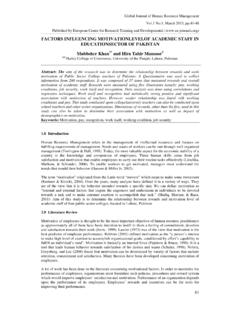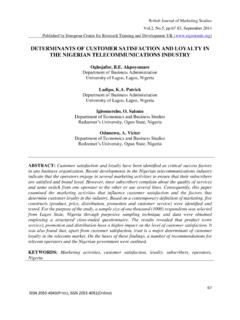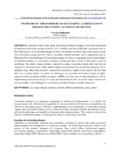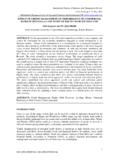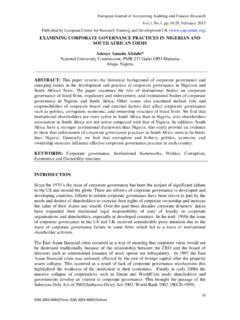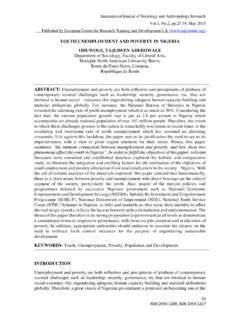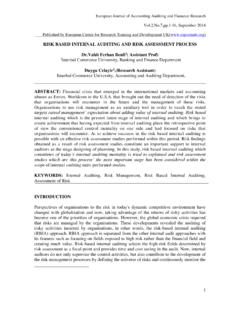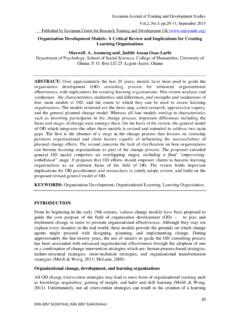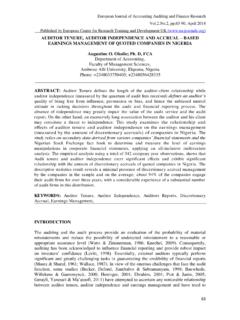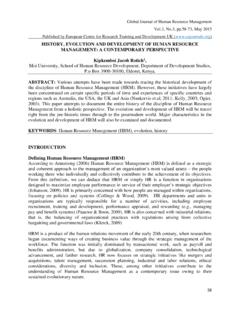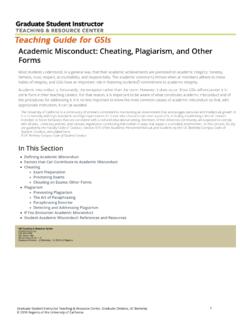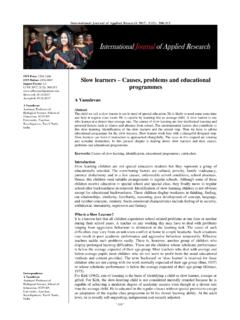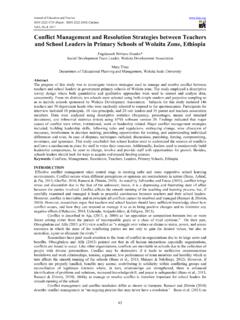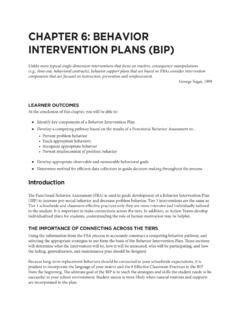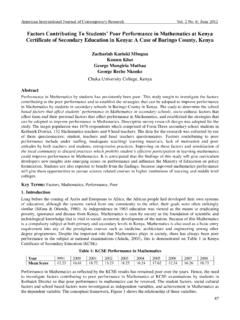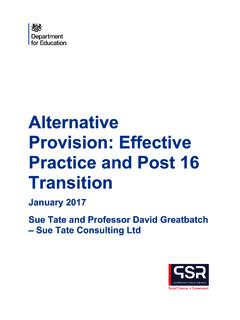Transcription of FACTORS THAT INFLUENCE STUDENT BEHAVIOUR IN …
1 European Journal of Educational and Development Psychology , , , December 2017 ___Published by European Centre for Research Training and Development UK ( ) 27 ISSN 2055-0170(Print), SSN 2055-0189(Online) FACTORS THAT INFLUENCE STUDENT BEHAVIOUR IN SECONDARY SCHOOLS Dr. Louis Jinot Belle ( ) Department of Education, Open University of Mauritius, Reduit, Mauritius ABSTRACT: The focus of this paper is to review, examine and discuss the main FACTORS that INFLUENCE the BEHAVIOUR of the secondary school students who are adolescents. The adolescent STUDENT is often in a difficult phase of his/her life and, therefore, important people in his/her life may negatively INFLUENCE his/her BEHAVIOUR at school. FACTORS that are related to the external system of his/her life are considered in this literature study. The study reveals that the school, the family, the peer pressure, the community and the new media negatively impact on the STUDENT BEHAVIOUR .
2 It concludes that these same systems should endeavour to teach socio-emotional skills to the students: this is likely to enhance their social competence. This may help eliminate STUDENT disruptive BEHAVIOUR : this problem is a socio-emotional problem that requires socio-emotional approaches. KEYWORDS: FACTORS , Adolescent, Disruptive BEHAVIOUR , Socio-Emotional Problem INTRODUCTION Education is the medium by which an individual achieves success in his/her life, in the society and in the world, and it lays the foundation of personality (Kumar, 2017). According to the Mauritian Ministry of Education and Human Resources (2014), the secondary school provides an education that enables the fulfilment of the four pillars of the Delors Report, namely learning to know, learning to do, learning to be, and learning to live together. It should also provide the adolescent STUDENT with the necessary skills that allow him/her to adjust easily and smoothly to the rapid physical, emotional, mental and social changes (Garcia & Santiago, 2017).
3 Indeed, the adolescence represents the period between 13 and 19 years old (Naganandini, 2017) when students manifest an identity crisis that may have an impact on their mental make-up and attitudes towards people and circumstances (Mutemeri & Gudyanga, 2008; Nealis, 2014). Indeed, this critical phase of their life may also affect the quality of their relationships with educators, the principal, the school superintendent as well as with their school mates (Kumari & Kumar, 2017). In addition to the modification of their BEHAVIOUR due to the transition phase of their life, secondary school students also change their BEHAVIOUR on account of many other FACTORS that are external. Dupper (2010) maintain that students misbehave because there are mismatches between their needs and the socio-environmental FACTORS that are within their immediate environment. STUDENT misbehaviour is not only the naughty BEHAVIOUR of the STUDENT but also the BEHAVIOUR that disturbs the effective teaching and learning process (Ghazi, Gulap, Muhammad & Khan, 2013) and that interrupts the saner and safer school environment (Schleicher, 2015).
4 STUDENT misbehaviour is a source of worry for all school stakeholders (Gutuza & Mapolisa, 2015; Marais & Meier, 2010; Ramjanally, 2015). It is a multifaceted and complex school problem that is manifested in various forms (Ali, Dada, Isiaka & Salmon 2014). The various European Journal of Educational and Development Psychology , , , December 2017 ___Published by European Centre for Research Training and Development UK ( ) 28 ISSN 2055-0170(Print), SSN 2055-0189(Online) common forms of STUDENT misbehaviour are late coming, bunking classes, drug and alcoholic abuse, bullying, love affairs, vandalism, assault on the school prefects, insult on educators, wearing the wrong school uniform, use of the mobile phone, smoking, writing or using foul language in class, work not done, class disruption and immoral acts (Gutuza & Mapolisa, 2015; Ghazi, Gulap, Muhammad & Khan, 2013; Ngwokabuenui, 2015; Jeeroburkhan, 2016).
5 STUDENT misbehaviour, however, is linked to academic performance and vice versa (Olley, Cohn, Cowan, 2010; Madziyire, 2012). The principal s role is to design and implement the most effective learner discipline management strategies in order to instill a positive school climate. However, to be successful as an effective learner discipline management leader in his/her school, the principal must understand the various causes of STUDENT BEHAVIOUR that are predominant in the school. Purpose of the study Since disruptive BEHAVIOUR from secondary school students is a major and persistent administrative problem as well as a public health problem, it is of utmost importance to review the existing literature on the problem. It is always basically recommendable to determine and understand the root causes of a problem when people aim at controlling it or preventing it from worsening. Indeed, when it comes to STUDENT discipline, there is often a blame game whereby parents shift the responsibility to the parents and vice versa, or principals is ineffective in dealing with STUDENT misbehaviour due to a lack of knowledge about the potential causes of this lack of discipline in their school.
6 A sound knowledge of the causes of indiscipline in the Mauritian context is the fundamental knowledge that the principals, in particular must have to be successful school leaders. The purpose of the paper is to review the causes of STUDENT misbehaviour in secondary schools with adolescent students. Such a review allows the principals, educators, superintendents, parents and the higher educational authorities to decide on the possible disciplinary strategies and interventions that may be adopted and implemented in order to maintain or restore positive BEHAVIOUR among secondary school students through a comprehensive school-wide positive discipline framework that would require the collaboration of all of these stakeholders. LITERATURE REVIEW The literature review focuses on the external and school-related FACTORS that INFLUENCE the BEHAVIOUR of the students of secondary schools. They are FACTORS that emerge from within the immediate environment of the adolescents.
7 These FACTORS are related to the external system, namely the school, peer pressure, the family, the community and the media. They are the social systems in which students are influenced by other people in their daily life (Marais & Meier, 2010). The school The school is the place where adolescents spend most of their daily time, interacting and socialising with others. It is the natural social setting for them. However, it is also in this socio-temporal space that the STUDENT BEHAVIOUR is influenced. In fact, the characteristics of the school may impact on the ways in which the students behave with others. Panchoo (2016), Ugboko & Adediwura (2012), Ramharai, Curpen and Mariaye (2012), Pascal (2015), Gutuza and Mapolisa (2015) and Edinyang (2017) found the following school features that encourage students to misbehave: overcrowded classroom; too much harsh discipline measures; STUDENT European Journal of Educational and Development Psychology , , , December 2017 ___Published by European Centre for Research Training and Development UK ( ) 29 ISSN 2055-0170(Print), SSN 2055-0189(Online) alienation; the feeling of disempowerment from the principal to deal with indiscipline; lack of effective leadership from the principal; inadequate supervision; absence of the teaching of social, creative, communication and interpersonal skills; lack of STUDENT voice and choice in their learning; the feeling of rejection by students; lack of care from friends, educators and the principal.
8 Lack of extracurricular activities and sport activities; the banning or controversial use of corporal punishment; and absence of academic support for students with academic and BEHAVIOUR problems. Besides, the educator is also a factor that INFLUENCE the STUDENT BEHAVIOUR negatively. Students may manifest disruptive BEHAVIOUR when he/she makes ineffective use of innovative pedagogies; shows little interest in students; does not provide academic feedback and guidance; does not communicate effectively; fails to plan in a proactive manner; uses punitive or reactive measures; teaches an irrelevant curriculum; comes late to class; uses the mobile phone in class; does have the leadership and authority to discipline the mischievous students; adopts a self-defeating attitude to the problem of a lack of discipline (Gambo & Muktar 2017; Daly, Der-Martirosian, Ong-Dean & Wishard-Guerra, 2011; Wolhuter & Russo, 2013; Rampa, 2014; Gitome, Katola & Nyabwari, 2013; Silva, Negreiros & Albano, 2017).
9 The end of character education in state secondary schools is also a contributing factor to STUDENT misbehaviour. Disgrace (2016) found that educators fail to inculcate positive and good BEHAVIOUR among students, and this is likely to have an impact on what the students conceive as acceptable and unacceptable BEHAVIOUR . In the same vein, Silva, Negreiros and Albano (2017) add that the absence of religiousness has encouraged students to deviate from cultural and traditional patters and social norms. Following the STUDENT Rights Contestation period (1969-1992), the Tinker v Des Moines Independent Community School in 1969, the Goss v Topez case in 1975 and the Bethel v Frazer case in 1986 in USA, the students rights are recognised and there has been a fall in the school authority to discipline students (Arum, 2005; Schimmel, 2006; Moyo, Khewu & Bayaga, 2014). Furthermore, many countries have ratified the United Nations Conventions on the Rights of the Child (1989), the African Charter on the Rights of the Child (1990), based on which they have passed on various legislations to protect the rights of the child as each nation has such a human rights obligation (Save the Children, 2017).
10 Violation of human rights distorts academic performance and prevent the effective and smooth process of personality development (Manzoor, 2017). Also, corporal punishment is found to be associated with lower IQs, smaller vocabularies, poor cognitive development (Portela & Pells, 2015). This has led to the banning of corporal punishment in schools. However, according to Save the Children (2017), poor STUDENT discipline is to the result of the failure to inflict corporal punishment; yet educators and even parents believe that corporal punishment is effective in teaching a lesson as it is a BEHAVIOUR modification strategy (Mugabe & Maposa, 2013). In this legal context, principals and educators do not take the risk of prosecution for child abuse and they feel that their power to discipline students has been reduced; they feel disempowered (Coetzee, 2010). Peer pressure Adolescents are more likely to give in to peer pressure and manifest unacceptable BEHAVIOUR that may have a negative impact on themselves or on others (Gallani, 2015).
